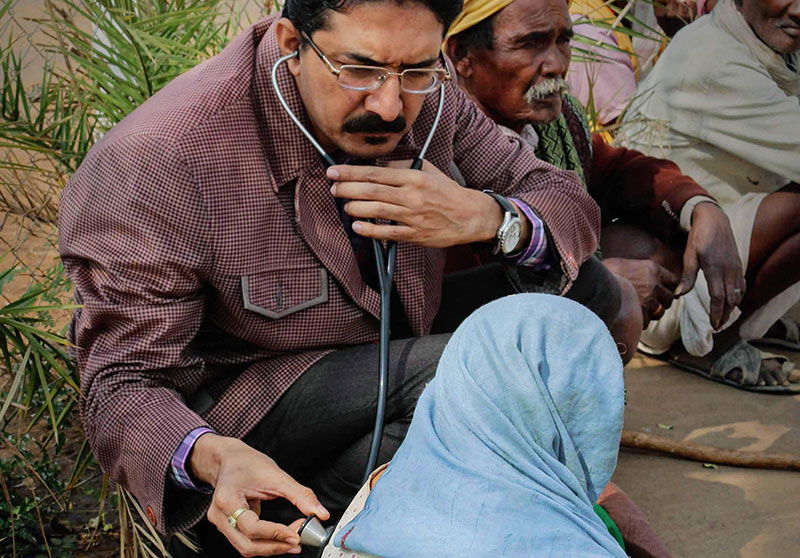Poverty is one of the major problems the world faces today. The continent of Asia particularly has over 40 percent of the 766 million people living on less than $1.90 a day. It makes Asia the second poorest continent in the world after Africa,[1] despite its significant economic progress in the past few decades, rendering poverty a key issue to be addressed.[2]
40%
of the 766 million people in Asia live on less than $1.90 a day
For many, poverty is mainly an economic, material, political, social and/or mental issue. However, for evangelical Christians, poverty is also a spiritual issue. Evangelical Christians have been actively involved in poverty alleviation around the world, particularly in the last half century.[3] Currently, there are hundreds of thousands of evangelical Christian churches, NGOs, and INGOs that have been working on poverty alleviation throughout Asia.
The Root Causes of Poverty in Asia
Understanding the root causes of poverty is the single most important thing to do in poverty alleviation. It is impossible to even think of alleviating poverty without going to its roots. Here are some of the root causes of poverty in Asia.
Widespread Corruption
‘Corruption diverts resources from the poor to the rich, leads to a culture of bribes, and distorts public expenditures, deterring foreign investors and hampering economic growth.’[4] Corruption has significantly hindered poverty alleviation in Asia. Countries like China, India, Bangladesh, Pakistan, Indonesia, Malaysia, and the Philippines, which together account for half the world’s population, all face widespread corruption.[5] Clearly, ‘corruption and poverty are two sides of the same coin. Ending one can help end the other.’[6]
It is impossible to even think of alleviating poverty without going to its roots.

Huge Population
As Asia has almost 60 percent of the world’s total population, some believe that high fertility causes poverty and that lower fertility is the key to reducing poverty. Others argue that poverty causes high fertility because poor people want more children to provide household labor and social security during their old age.[7]
However, ‘poverty, inequality and high fertility are closely associated. Poor households tend to have many children owing mainly to lack of access to and knowledge of contraceptives, low autonomy among women, and the demand for children for economic or household support. These fertility differentials perpetuate intergenerational poverty and inequalities.’[8] So, huge populations, coupled with the lack or misuse of resources, is one of the root causes of poverty in Asia.[9]
Recurring Natural Disasters
Another root cause of the problem of poverty in Asia is recurring natural disasters—floods, typhoons, volcanic eruptions, landslides, etc. ‘Asian countries are mostly dependent upon agriculture, forestry and tourism, which can all be affected by natural disasters. In 2015 half of the world’s natural disasters took place in the Asia-Pacific region, causing significant economic losses.’[10]
2014-2017
870
million
people in Asia lost their livelihoods or were relocated due to natural disasters
In 2014-2017, over 870 million people in Asia lost their livelihoods or were relocated due to natural disasters.[11] The majority of slum dwellers in major cities in Asia come from places affected by frequent natural disasters.[12]
Lack of Education
According to ChildFund International, ‘Poverty and education are inextricably linked, because people living in poverty may stop going to school so they can work, which leaves them without literacy and numeracy skills they need to further their careers. Their children, in turn, are in a similar situation years later, with little income and few options but to leave school and work.’[13]
At the micro level, illiterate individuals are less productive, get less-paying jobs, and maintain very low living standards, mostly below the poverty line. At the macro level, countries with illiterate or uneducated populations cannot achieve significant progress, cannot increase their output substantially, and as a result survive at low living standards. So lack of education is clearly one of the root causes of poverty in Asia.
The Four Dimensions of Poverty
People usually understand poverty as primarily an economic condition. While this is certainly one aspect of poverty, it does not capture its full scope and effect. There are also other kinds of poverty that people are facing. In this article, we will focus on four dimensions of poverty.
Economic Poverty
Though poverty is a complex and multi-dimensional phenomenon, it is usually defined in economic terms. People are poor because they lack the resources to get the things they need. Economic poverty is the lack of basic necessities for material well-being. Some of these basic needs are food, clothing, housing, clean water, land, and other assets.
The most common definition of poverty comes from the World Bank, which considers poverty as a situation where a person is living below the income of $3.20 per day and extreme poverty as a situation where a person is living below the income of $1.90 per day.[14] The World Bank comes up with these figures based on the average poverty line in the world’s 15 poorest countries. Economic poverty usually affects the psychological, social, and spiritual aspects of a person.
Social Poverty
Social poverty, also understood as relational poverty, is a severe lack of the connectedness with others that people need for their well-being. It involves the lack or denial of resources, rights, goods, and services, and the inability to participate in the normal relationships and activities available to the majority of people in a society, whether in economic, social, cultural, or political arenas.[15]
Psychological poverty is the state of having an unhealthy and poor frame of mind. Poor people tend to believe not only that they are poor, but that they will remain poor.
Likewise, globalization and labor markets have also contributed to social poverty. For instance, approximately 3.5 million Nepalese (14% of total population) are working abroad.[16] Though remittances from the migrant workers play a vital role in sustaining the national economy, they create social poverty in the form of loneliness, marital problems, parenting issues, identity crises, and other social problems.
Psychological Poverty
Psychological poverty is the state of having an unhealthy and poor frame of mind. Poor people tend to believe not only that they are poor, but that they will remain poor. Psychological poverty is usually self-inflicted. If a person has a poverty mindset, then he/she is the only person who can pull him/herself out of it.[17]

Johan Janse van Rensburg writes, ‘When investigating the phenomenon of poverty, the question is not only why people are poor, but also and most importantly, why people remain poor.’[18] Mental poverty hinders the ability to make positive choices and shackles the poor to an endless cycle of poverty. So it is not about poor people, but about any people who find themselves poor.[19]
Spiritual Poverty
Spiritual poverty is the state of incompleteness before God. When people experience neediness, incompleteness, and dependency, they often become overwhelmed. When people see their brokenness, they do not feel better about themselves; instead, they feel that something is terribly wrong within themselves. In fact, it does not matter whether they have problems or struggles in life or not; they still need God.
On the subject of spiritual poverty, Matthew 5:3 is a verse that usually comes up in evangelical Christian contexts. In the original language, ‘poor’ in this context implies ‘lacking in spiritual worth.’[20] Jesus calls this a ‘blessed’ condition because it helps people to draw closer to God. People need God’s grace and mercy. However, not everyone is aware of his or her neediness. For those who are aware of their neediness, Jesus describes them as not just ‘poor in spirit’, but ‘blessed’.[21]
A Holistic Approach to Poverty Alleviation
Since the four dimensions of poverty are interrelated, the response to them should be integrated as well. In other words, ‘Breaking the cycle of poverty involves a holistic approach to development.’[22] In this article, we will use the Holistic Development Framework[23] to explain a holistic approach to poverty alleviation.
The Holistic Development Framework is an approach to understand poverty and to respond to it in a comprehensive manner. This framework proposes an intentional integration of economic, psychological, social, and spiritual development. The goal of holistic development is shalom. What comes to our mind when the word shalom is spoken? Is it absence of war, a sense of calm, an absence of conflict? The word shalom is usually translated as ‘peace’ in English. But translating shalom into one word alone does not give the full depth and richness of its meaning.
Shalom is a word with a comprehensive meaning, including peace, wholeness, completeness, soundness, health, safety, and prosperity, carrying with it the implication of permanence.
Shalom is a beautiful classical Hebrew word, transliterated as šālôm. The triliteral root it derives from, ŠLM, means variously in its different verbal stems, to be completed, ready; to remain healthy, unharmed; to keep peace; to make restitution; to recompense, reward, restore; to finish; to deliver up; to be at peace.[24] So shalom is a word with a comprehensive meaning, including peace, wholeness, completeness, soundness, health, safety, and prosperity, carrying with it the implication of permanence. When evangelical Christians respond to poverty economically, psychologically, socially, and spiritually, poor people will experience shalom.
William Carey, considered the father of modern missions, has set a great example on how evangelical Christians should alleviate poverty in a holistic manner. In addition to preaching and planting churches in India, Carey worked on reforming the cultural systems and empowering the people through his advocacy and writings. Speaking out against the caste system, protesting sati (a practice among Hindus in India that burns a widow to death on her husband’s pyre), teaching agriculture, and building systems of higher education in India are examples of his holistic response to the needs of the people in India. He integrated all of these activities with his evangelistic efforts in order to help in the holistic development of the people.[25]

Loving the Poor like Jesus
It is good to do a food program once a week, give away used clothes once a month, and organize a Christmas party once a year for the poor. However, to alleviate poverty requires much effort, intentionality, and resources.
Preaching the gospel to the poor as Jesus did is an important aspect of responding to the spiritual needs of the poor. However, he also fed the 4,000 and the 5,000 and healed the sick, responding to their physical needs. In addition, he ate with sinners and tax collectors, and he accepted them as they were, responding to their social and psychological needs.
It is evident that Jesus responded to the needs of people in a holistic manner. Likewise, when we address economic, psychological, social, and spiritual dimensions of poverty in a holistic manner, people will experience shalom. Therefore, it is important for evangelical Christians to understand and to apply a holistic approach in alleviating poverty.
Endnotes
- Mahua Mitra, ‘8 Important Facts About The Causes Of Poverty In Asia,’ January 27, 2018, https://borgenproject.org/causes-of-poverty-in-asia/.
- ‘Poverty in Asia,’ World Vision, last modified November 1, 2019, https://www.worldvision.org.hk/en/learn/poverty-in-asia.
- Andrew Olse, ‘Evangelicals and International Aid: Insights from a Landscape Survey of U.S. Churches,’ (Medford, MA: The Fletcher School, Tufts University, and South Hamilton, MA: The Center for the Study of Global Christianity, Gordon-Conwell Theological Seminary, 2016), 5.
- Sri Mulyani Indrawati, ‘The way out of poverty and corruption is paved with good governance,’ World Bank Blogs, May 12, 2016, https://blogs.worldbank.org/voices/way-out-corruption-paved-good-governance.
- Kumar Aryal, Poverty and Development: Evangelical Christian Response to Poverty in the Philippines (Seattle, Washington: Amazon Digital Services LLC, 2019).
- Ruben C. De Lara, ‘Must We Aim for Ending Corruption and Poverty?’ Manila Times, February 22, 2018, https://www.manilatimes.net/2018/02/22/opinion/analysis/must-aim-ending-corruption- poverty/381895/381895/.
- Thomas W. Merrick, ‘Population and Poverty: New Views on an Old Controversy,’ International Perspectives on Sexual and Reproductive Health, March 1, 2002, https://www.guttmacher.org/journals/ipsrh/2002/03/population-and-poverty-new-views-old-controversy.
- ‘Population dynamics and inequality in Asia and the Pacific,’ United Nations: Economic and Social Council, Economic and Social Commission for Asia and the Pacific, September 20, 2018, https://www.un.org/en/development/desa/population/commission/pdf/52/regionalevents/escap/APPC2.pdf.
- Mitra, ‘8 Important Facts’.
- Mitra, ‘8 Important Facts’.
- J. Wood, ‘Why Asia-Pacific is especially prone to natural disasters,’ December 6, 2018, https://www.weforum.org/agenda/2018/12/why-asia-pacific-is-especially-prone-to-natural-disasters/.
- Aryal, Poverty and Development.
- ‘Poverty and Education,’ ChildFund International, https://www.childfund.org/about-us/education/, accessed March 23, 2022.
- ‘Poverty and Equity Brief: East Asia & Pacific – Philippines,’ World Bank Group, October 2019, https://databank.worldbank.org/data/download/poverty/33EF03BB-9722-4AE2-ABC7-AA2972D68AFE/FM2019/Global_POVEQ_PHL.pdf.
- R. A. Levitas, ‘The Concept and Measurement of Social Exclusion,’ in Christine Pantazis, David Gordon, & R. Levitas, eds., Poverty and Social Exclusion in Britain: The Millennium Survey (Bristol, UK: Policy Press, 2006).
- Anita Ghimire, ‘Nepal brief,’ MIDEQ, https://www.mideq.org/en/resources-index-page/nepal-brief/, accessed March 16, 2022.
- Canice Parker, ‘Mental Poverty and Factors of Poverty – Reasons for Famine,’ January 12, 2012, https://ezinearticles.com/?Mental -Poverty-and-Factors-of-Poverty-Reasons-for- Famine&id=6818109.
- Johan Janse van Rensburg, ‘The Psychology of Poverty,’ Verbum et Ecclesia 34, February 28, 2013, (1): 1, https://www.researchgate.net/publication/274128709_The_psychology_of_poverty.
- Anandi Mani, Sendhil Mullainathan, Eldar Shafir, and Jiaying Zhao, ‘Poverty Impedes Cognitive Function,’ Science 341.6149, August 30, 2013.
- Frederick W. Danker and Walter Bauer, A Greek-English Lexicon of the New Testament and Other Early Christian Literature, Third Edition (Chicago, IL: University of Chicago Press. 2000).
- Anne Bradley and Arthur W. Lindsley, eds., For the Least of These: A Biblical Answer to Poverty (Bloomington, IN: WestBow, 2014).
- ‘The Problem of Poverty in Asia,’ Compassion International, https://www.compassion.com/poverty/poverty-in-asia.htm, accessed March 24, 2022.
- Framework adapted from Bruce Wydick, ‘Economists Discover Holistic Development: And 5 Reasons Why It’s Likely More Effective,’ Across Two Worlds, June 29, 2015, http://acrosstwoworlds.net/?p=357.
- Ludwig Koehler and Walter Baumgartner, et al., ‘ŠLM,’ Hebrew and Aramaic Lexicon of the Old Testament, vol 4. (Leiden, NL: Brill Academic Publishers, 1994).
- Al Tizon, Transformation after Lausanne: Radical Evangelical Mission in Global-Local Perspective (Oxford, UK: Regnum Books International, 2008).
Photo credits
Image by binaryscalper from Pixabay
Photo by Ibrahim Rifath on Unsplash


